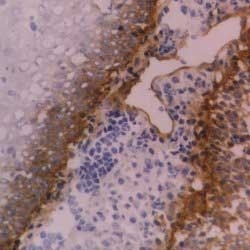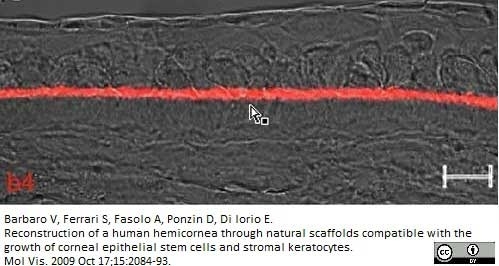CD104 antibody | 450-9D


Mouse anti Human CD104
- Product Type
- Monoclonal Antibody
- Clone
- 450-9D
- Isotype
- IgG1
- Specificity
- CD104
| Mouse anti Human CD104 antibody, clone 450-9D recognizes the human beta4 integrin, also known as CD104. CD104 is a ~205 kDa glycoprotein which associates with the alpha6 integrin to form the alpha6/beta4 complex. CD104 is expressed on epithelial cells, Schwann cells and various tumor cell lines. Mouse anti Human CD104 antibody, clone 450-9D recognizes an extracellular epitope on the CD104 molecule. |
- Target Species
- Human
- Species Cross-Reactivity
-
Target Species Cross Reactivity Mustelid Expected from Sequence Ferret Mink - N.B. Antibody reactivity and working conditions may vary between species.
- Product Form
- Purified IgG - liquid
- Preparation
- Purified IgG prepared by affinity chromatography on Protein G from tissue culture supernatant
- Buffer Solution
- Phosphate buffered saline
- Preservative Stabilisers
- 0.09% sodium azide (NaN3)
- Carrier Free
- Yes
- Immunogen
- Purified alpha6 beta4 integrin from A431 cells.
- Approx. Protein Concentrations
- IgG concentration 1.0 mg/ml
- Fusion Partners
- Spleen cells from immunised BALB/c mice were fused with cells of the mouse Sp2/0 myeloma cell line.
- Regulatory
- For research purposes only
- Guarantee
- 12 months from date of despatch
Avoid repeated freezing and thawing as this may denature the antibody. Storage in frost-free freezers is not recommended.
| Application Name | Verified | Min Dilution | Max Dilution |
|---|---|---|---|
| Flow Cytometry | 1/25 | 1/100 | |
| Immunofluorescence | |||
| Immunohistology - Frozen 1 | 1/500 | 1/1000 | |
| Immunohistology - Paraffin | |||
| Immunoprecipitation | |||
| Western Blotting |
- 1The epitope recognised by this antibody is reported to be sensitive to formaldehyde fixation and tissue processing. Bio-Rad recommends the use of acetone fixation for frozen sections.
- Flow Cytometry
- Use 10μl of the suggested working dilution to label 106 cells in 100μl
- Histology Positive Control Tissue
- Human tonsil
| Description | Product Code | Applications | Pack Size | List Price | Your Price | Quantity | |
|---|---|---|---|---|---|---|---|
| Mouse IgG1 Negative Control | MCA928 | F | 100 Tests |
|
Log in | ||
| List Price | Your Price | ||||||
|
|
Log in | ||||||
| Description | Mouse IgG1 Negative Control | ||||||
Source Reference
-
Kennel, S.J. et al. (1990) Second generation monoclonal antibodies to the human integrin alpha 6 beta 4.
Hybridoma. 9 (3): 243-55.
References for CD104 antibody
-
Aasted, B. & Viuff, B. (2007) Reactivity of monoclonal antibodies to human CD antigens with cells from mink.
Vet Immunol Immunopathol. 119 (1-2): 27-37. -
Barbaro, V. et al. (2009) Reconstruction of a human hemicornea through natural scaffolds compatible with the growth of corneal epithelial stem cells and stromal keratocytes.
Mol Vis. 15: 2084-93. -
Martel, C.J. & Aasted, B. (2009) Characterization of antibodies against ferret immunoglobulins, cytokines and CD markers.
Vet Immunol Immunopathol. 132:109-15. -
Lai-cheong, J.E. et al. (2009) Loss-of-function FERMT1 mutations in kindler syndrome implicate a role for fermitin family homolog-1 in integrin activation.
Am J Pathol. 175 (4): 1431-41. -
Groves, R.W. et al. (2010) A homozygous nonsense mutation within the dystonin gene coding for the coiled-coil domain of the epithelial isoform of BPAG1 underlies a new subtype of autosomal recessive epidermolysis bullosa simplex.
J Invest Dermatol. 130 (6): 1551-7. -
Smith, K. et al. (2011) Mono- and tri-cationic porphyrin-monoclonal antibody conjugates: photodynamic activity and mechanism of action.
Immunology. 132: 256-65. -
Alam, H. et al. (2011) Loss of keratins 8 and 18 leads to alterations in α6β4-integrin-mediated signalling and decreased neoplastic progression in an oral-tumour-derived cell line.
J Cell Sci. 124: 2096-106.
- Synonyms
- Integrin Beta 4
- RRID
- AB_2129143
- UniProt
- P16144
- Entrez Gene
- ITGB4
- GO Terms
- GO:0005515 protein binding
- GO:0004872 receptor activity
- GO:0008305 integrin complex
- GO:0007154 cell communication
- GO:0007160 cell-matrix adhesion
- GO:0007229 integrin-mediated signaling pathway
- GO:0007275 multicellular organismal development
- GO:0031581 hemidesmosome assembly
Please Note: All Products are "FOR RESEARCH PURPOSES ONLY"
View all Anti-Human ProductsAlways be the first to know.
When we launch new products and resources to help you achieve more in the lab.
Yes, sign me up
